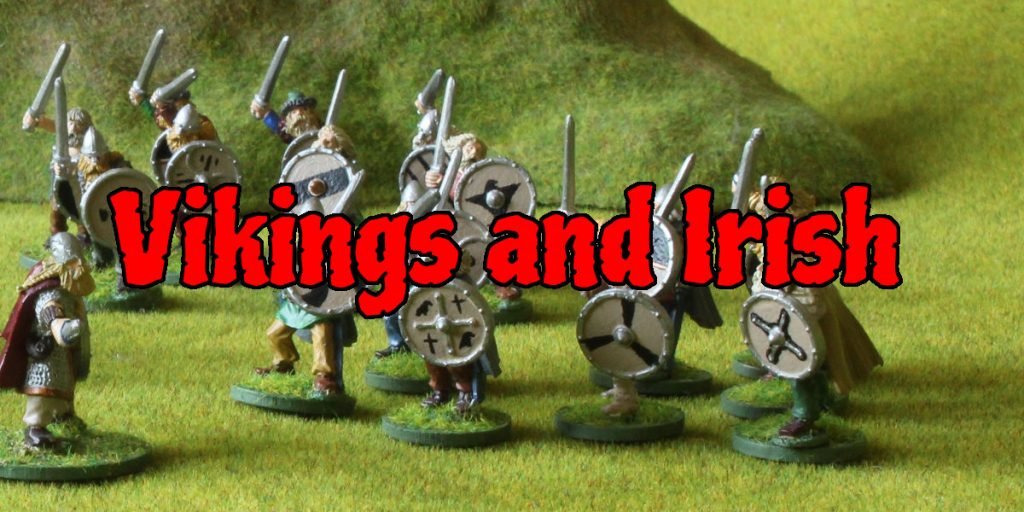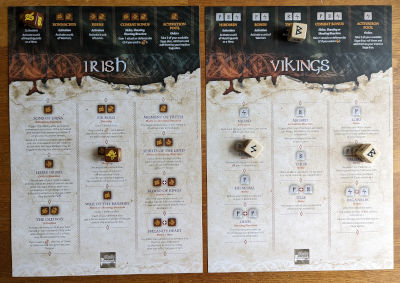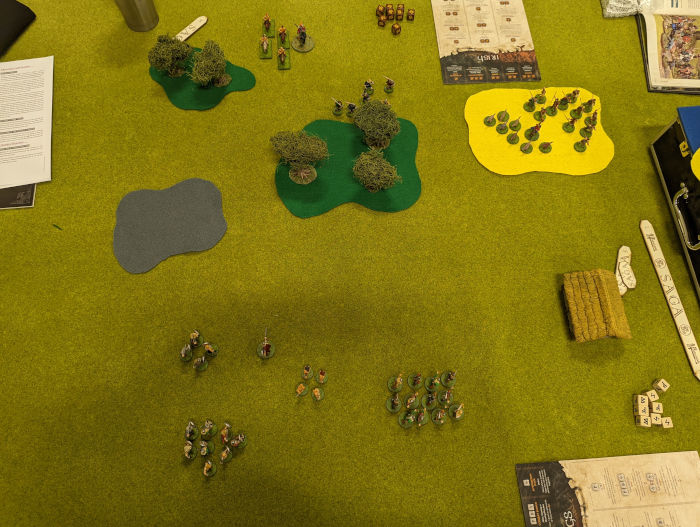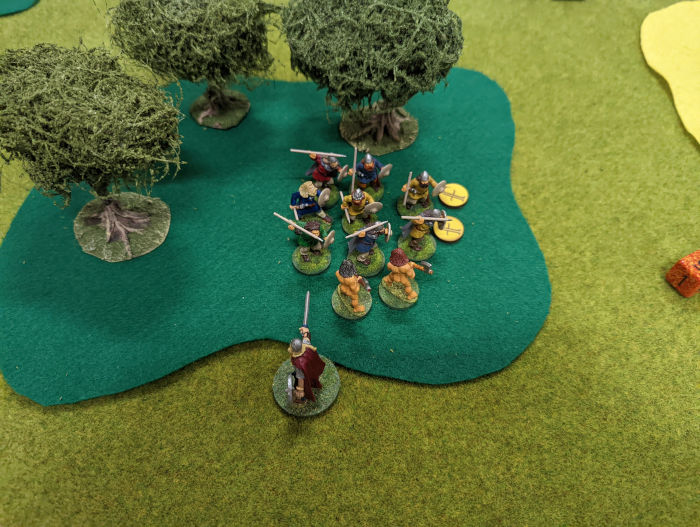Battle of Three Tree Woods

We had our first Saga: Age of Vikings game for a long while. A small band of Vikings, led by Ivar Ivarson clashed with a local Irish warlord. With the Irish taking heavy advantage of their knowledge of the land, things didn’t go all that well for the Vikings.
Saga is an interesting game system. It’s designed for 28mm skirmish, with about half a dozen or so units and normally 4-12 figures per unit. It is predominantly focused on the dark ages, with the Age of Vikings supplement covering the usual such as Vikings, Anglo Saxons and Normans, but also Pagan Rus, Carolingians and the Last Romans (and others). There are also supplements for Age of Hannibal and Age of Crusades, as well as the Age of Magic which is geared towards fantasy.
The basic rules are pretty straightforward, as is building a warband. There are four basic types of troops. You have Heroes (of which your Warlord is one), Hearthguards (elite troops), Warriors (core troops) and levies (barely trained). You get a warlord for free, then it’s one point for a unit of:
- Hearthguards x4
- Warriors x8
- Levies x12
That’s pretty much it. We had a 4pt skirmish, so four units plus a warlord. Some armies get special variants of the above (so I converted a unit of Hearthguards to a unit of Berserkers), and there can be options of choices such as mounted v infantry, as well as bows or heavy weapon etc. But building a warband shouldn’t take more than a couple of minutes.

The complication is in the dice and the battle boards. Each type of army gets its own special dice. These are just d6 with 3 funny symbols on them, so are an excuse to make money by forcing players to buy extra dice. I’m not a huge fan of special dice (I wasn’t a fan of Edge of the Empire because of this), mostly because they tend to be hard to get, and once the game goes out of print you’re sort of stuck.
But they do look nice, and give each culture a different feel. Fortunately it’s not a dice type per army. The Viking runic dice cover Vikings, Jomsvikings, Pagan Rus and Norse Gael. The Gaelic dice are used by the Scots, Irish and Picts.
What is unique for each army are the Battle Boards, and this is where the game gets complicated. Talking to a number of people at the club, these seem to be a turn-off for some since they do require a lot of thinking to use them effectively. But so far I’m quite liking them. They give each army some special features, which encourage a different type of play.

The boards detail the options available to each army. The Vikings tend to be aggressive, with lots of bonuses to melee. There are somewhat mythical options such as Valhalla, where you sacrifice warriors to give yourself a large attack bonus in a melee.
The Irish get options such as Sons of Dana (get a free attack against enemies moving close to uneven terrain) or Spirits of the Land (get defence bonuses if in uneven terrain). The Age of Vikings supplement is not fantasy, but it definitely goes for a mythical feel on the naming of abilities, which I quite like.
The Vikings and Irish do seem to be almost opposites of each other. The Vikings want to charge forward across open terrain to force their opponents into melee. The Irish want to hide within forests and fields and shoot the enemy whilst running away.
This makes the first stage of the game important – putting down terrain. The Irish want lots of it, and the Vikings want none.

The Vikings (led by Ivar Ivarson) went first for terrain placement, which is bad for them since it means more terrain got put down. A player can select to stop placing terrain after three pieces have been put down, then the opposing player gets to place one more piece. Since the Vikings got to place the third piece, the Irish placed a fourth, the Vikings ended placement, and then the Irish got to place a fifth.
For the first couple of turns the Irish mostly stayed where they were, just moving to occupy the woods. The Vikings moved up, and tried assaulting their position. It didn’t go well. Moving in the berserkers, who are very good on attack but weak on armour turned out to be a mistake.

The use of Heirs of Mil (can’t charge or target a unit hiding like cowards in uneven terrain unless within 2″ of them) meant I couldn’t charge the warriors in the woods directly, and needed to stop just outside the woods. Which allowed the use of Sons of Dana to shoot my berserkers and kill half of them.
Fortunately I had managed to use Odin to exhaust the warriors to prevent them from shooting themselves, so I managed to get close enough for a charge. It was 8 attack dice (Berserkers have 4 attack dice per figure, standard warriors have 1, halved if closing ranks to fight defensively) versus the four of the defensive warriors.
I forgot to take advantage of the the fatigue the warriors had, and then rolled badly. The warriors rolled well, both on attack and defence, and by berserkers were wiped out.
I should have pushed for a more aggressive attack than I did after that. I lost my second unit of Hearthguard to more missile fire. The javelin attacks of the Irish can be pretty lethal – the ability to shoot for free after a move is quite powerful. My archers required several activations to get them within range and then shoot. By which time their numbers had been depleted. It wasn’t helped by me getting the dice allocation wrong.
You need to spend a saga dice to active a unit, and levies are harder to active than warriors and hearthguard (the dice symbols are not equal in frequency, with one appearing once, another twice and the third three times on each die). I had a choice to use either a ᛋ or a ᚠ for an early activation, and chose ᛋ, leaving a ᚠ for the final shooting activation. Except my Levies require ᛋ or ᛒ. I couldn’t do anything (Futhark runes being available in Unicode is quite useful).
Losing units means you lose saga dice. We both started with rolling 5 dice. You need to spend dice to activate units and special abilities, so I was down to only a couple of dice. Things were not good for the Vikings.
Desperate to at least take some of the enemy down with us, the Viking unit of Bondi (warriors) managed to catch up with the unit of Irish warriors (Bonnachts) which consisted of a huntsman and some hounds. I had no special abilities to use, but for once fate favoured the Vikings and only a single hound survived, compared to two bondi.
The mounted Fianna (hearthguards) came out to play, trying to ride down the Viking Warlord. Ivar went down, but so did two of the Fianna.
It was a resounding victory for the Irish, but they didn’t come off completely unscathed. It was an interesting game, and really demonstrated that the use of terrain and the battle board abilities were crucial to the success of the Irish. The Irish player managed this well, and the Vikings could definitely have done things better. Increased luck on the dice would have helped the Vikings as well, but wouldn’t have changed the overall result.
Despite the loss (something I’m used to in wargaming), it was a fun game. There was a lot of looking up of rules and trying to figure out how things worked, but that’s normal for most games in their learning stages. We played it at the club rather than at home which was interesting as well, since we got to talk to other gamers and discuss their thoughts on the game. The usual Saga crowd weren’t around this time though.
We will undoubtedly play it again sometime, hopefully with a better understanding of both the rules and how to effectively use the battle boards. Learning how to use them really is critical in Saga.
1 Response